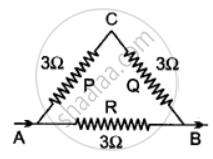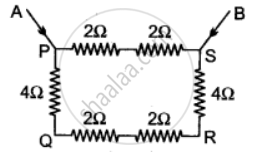Advertisements
Advertisements
प्रश्न
Two resistors of resistance 2 Ω and 3 Ω are connected in parallel to a cell to draw current 0.5 A from the cell. Calculate the current in each resistor.
उत्तर
If i is the current through 2 Ω resistance, then (0.5 - i) is the current through 3 Ω resistance.
∴ i × 2 = (0.5 - i) × 3 ∵ p.d. is same
2i = 1.5 - 3i
2i + 3i = 1.5
5i = 1.5
i = 0.3 A
∴ current through 2 Ω resistance = 0.3 A and
current through 3 Ω resistance = 0.5 – 0.3 = 0.2 A
संबंधित प्रश्न
Differentiate between resistances in series and parallel.
How can three resistors of resistances 2 Ω, 3 Ω and 6 Ω be connected to give a total resistance of 4 Ω ?
The equivalent resistance of the parallel combination of two resistors of 60Ω and 40Ω is _______.
A) 24Ω
(B) 100Ω
(C) 50 Ω
(D) 240Ω
A wire of resistance R1 is cut into five equal pieces. These five pieces of wire are then connected in parallel. If the resultant resistance of this combination be R2, then the ratio `R_1/R_2` is:
(a) `1/25`
(b)1/5
(c)5
(c)25
Are the lights in your house wired in series?
State how are the two resistors joined with a battery when potential difference is same across each resistor.
An electrical appliance has a rating 100 W, 120V. The resistance of element of appliance when in use:
The equivalent resistance of a parallel combination of two resistors of 30 Ω and 60 Ω is ______________.
Calculate equivalent resistance in the following cases:


Three resistors of 6Ω, 4Ω and 4Ω are connected together so that the total resistance is 8Ω. Draw a diagram to show this arrangement and give reason to justify your answer.
